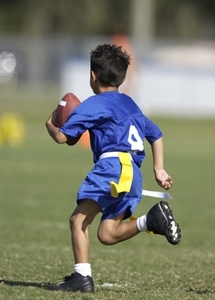If you've turned on the news, watched a football game or read a newspaper lately, you've likely come across headlines about the increase in sports injuries, particularly concussions.
Many popular team sports for kids and teens, like basketball, baseball, soccer and football, are high-impact and don't come without risks. However, there are a lot of benefits kids can gain from sports participation as well. Here are some things travel nursing professionals and parents might want to consider when it comes to kids and sports:
The benefits of team sports for kids
There's no doubt that team sports bring about a lot of benefits for kids and teens, both mentally and physically. They can build leadership skills, teach kids the lessons of working together as a team and build up their extracurricular activities for college applications. Additionally, sports can keep your kids physically fit and healthy, which is an important factor these days given the rate of childhood obesity in the U.S.
According to the Centers for Disease Control and Prevention, childhood obesity rates declined in 2013, which is a great sign that things are moving in the right direction. However, despite these reductions, 1 out of 8 preschoolers in the U.S. are still considered obese. What's more, the CDC indicates that obese children are more likely to become obese as adults, and as a result, suffer "lifelong physical and mental health problems."
State and local officials as well as parents have made strides to correct these issues by creating partnerships with local communities to promote physical activity and help local schools set up sports fields so that more children can safely play. Limiting a child's computer and TV time has also proved beneficial in these efforts.
However, with more of a focus on childhood sports activities, there are clear risks that parents need to keep in mind as well.
The risks of team sports for kids
Any physical activity is going to put people at risk of injury, but for kids, these risks are even higher, as children's bones and muscles are still developing. Kids usually want to succeed at their sport as well, which can cause some athletes to exert themselves too much in practices and games, also leading to injuries.
Kids can also greatly differ in their levels of size and maturity, according to the American Academy of Orthopaedic Surgeons. Growth plates that are found in the long ends of bones can become weak based on a child's development rate, which can lead to broken bones and fractures. These risks only become greater in high school sports competition, which typically requires student athletes to become bigger, faster and stronger, even though their bodies are still developing.
The rates of participation in youth football leagues are falling
As of late, many parents have grown concerned about the rate of concussions in many team sports, especially football, where head-on collisions can occur. According to 2013 ESPN data, youth football participation in the nation's largest youth football program, Pop Warner, dropped by 9.5 percent from 2010 to 2012. This marked the largest two-year decline the organization has seen since it began allocating such information decades ago.
According to the organization's chief medical officer, Dr. Julian Bailes, concerns about head injuries were the No. 1 cause for the decline. Even former NFL stars have been telling sources that they are not allowing their children to play football, showing a major discord between America's favorite sport and youth participation.
While it's ultimately up to parents to decide whether or not sports participation is right for their children, parents should take steps to make sure that their children are active so that they can grow up to be healthy and happy adults.

